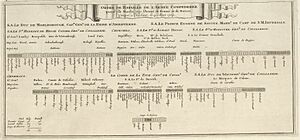Blenheim order of battle facts for kids

The Battle of Blenheim was a major fight during the War of the Spanish Succession. It happened on August 13, 1704. This page tells you about the different armies and their main leaders and groups that fought in this important battle. Knowing the "Order of Battle" helps us understand how the armies were organized. It shows which units were part of each side.
Contents
Who Fought at Blenheim?
The Battle of Blenheim involved two main sides. On one side were the Allied forces. These included soldiers from England, the Holy Roman Empire (like Austria and some German states), and the Dutch Republic. On the other side were the Franco-Bavarian forces. These were soldiers from France and Bavaria.
The Allied Army
The Allied Army was a mix of different nations. They worked together under strong leaders. Their goal was to stop France from becoming too powerful in Europe.
Key Leaders
The main commander for the Allied Army was John Churchill, the Duke of Marlborough. He was a brilliant general from England. Another very important leader was Prince Eugene of Savoy. He led the Imperial Austrian forces. These two generals worked closely together.
British and Hessian Forces
The Allied Army was divided into different sections. One important section was the Blenheim Column. This group was led by Lieutenant General John, Lord Cutts. It included many infantry (foot soldiers) and cavalry (horse soldiers).
Some of the British infantry regiments included:
- Howe's Regiment of Foot
- The Welch Regiment of Fusiliers
- The Duke of Marlborough's Regiment of Foot
Hessian soldiers from Hesse-Kassel also fought here. They had regiments like Prinz Wilhelm Infantry and Hessian Grenadiers. Cavalry units like Wood's Regiment of Horse provided support.
Central Allied Forces
The center of the Allied Army was led by Lieutenant General Charles Churchill. This part of the army also had many infantry and cavalry units. They came from various places. These included Hanover, Lüneburg-Celle, and Württemberg.
Some of the infantry units in the center were:
- Schöpping Infantry Regiment (Hesse-Kassel)
- Württemberg Regiment Stenfels
- Holstein-Beck's Brigade, with units from Ansbach and Switzerland.
The cavalry in the center included regiments like Leib Horse Cuirassier and von Bülow's Dragoons. These horse soldiers were very important for charging the enemy.
Imperial Austrian Army
The right side of the Allied Army was the Imperial Austrian Army. It was commanded by Field Marshal Prince François Eugène von Savoy-Carignan. This army also had many cavalry and infantry units. They were crucial for the battle.
Key cavalry units included:
- Natzmer's Brigade from Prussia, with Leib Dragoons and Margraf Philip's Horse Cuirassier Regiment.
- Fugger's Brigade from Austria, with Alt-Hanover Cuirassiers.
- Durlach's Brigade, including Limburg-Styrum's Dragoons.
The infantry forces were led by Leopold, Fürst von Anhalt-Dessau. They had strong Prussian regiments. These included the Grenadier Garde and Anhalt-Dessau Infantry Regiment. Danish soldiers also supported the Imperial Army.
Allied Artillery
The Allied Army had a strong artillery force. It was led by Colonel Holcroft Blood. Artillery units used cannons of different sizes. These included sakers, howitzers, and demi-culverins. They fired heavy shots at the enemy.
The Franco-Bavarian Army
The Franco-Bavarian Army was led by Marshal Camille d'Hostun de la Baume, Duc de Tallard. He was a French Marshal. The Bavarian forces were led by Prince Maximillian II Emmanuel Wittelsbach, the Elector of Bavaria. Marshal Ferdinand de Marsin was his second-in-command.
French Forces
The French army had several key sections. The Blenheim Wing Command was led by Lieutenant General Philippe, Marquis de Clérambault. This section included dismounted dragoons and a large garrison in the village of Blenheim.
Some of the regiments defending Blenheim were:
- Regiment de Navarre (three battalions)
- Régiment d'Artois (two battalions)
- Regiment de Greder Allemande (German soldiers)
Between Blenheim and Oberglauheim, French cavalry and infantry were positioned. This area was important for connecting the different parts of their army. Units here included the Gendarmerie de France and Regiment du Roi.
Bavarian Forces
The Elector of Bavaria's army was a key part of the Franco-Bavarian forces. It included both cavalry and infantry.
Important cavalry units were:
- Regiment de Royal
- Regiment de Prince Charles de Lorraine
- Regiment d'Anlezy
The infantry included regiments like:
- Regiment de Champagne
- Bourbonnais
- Régiment de la Reine
Irish regiments, like Dorrington's Regiment and Clare's Regiment, also fought with the Bavarians. These were Irish soldiers serving in the French army.
Franco-Bavarian Artillery
The Franco-Bavarian Army also had many cannons. The Royal Artillery was led by the Marquis de Frezeliere and the Marquis de Houville. They had various types of cannons, from 4-pounders to heavy 24-pounders. Many smaller 4-pounder cannons were spread out along the front lines.
Sources
- Higgins, David R. "Tactical File: The Famous Victory: Blenheim, 13 August 1704." Strategy & Tactics, Number 238 (September 2006).


